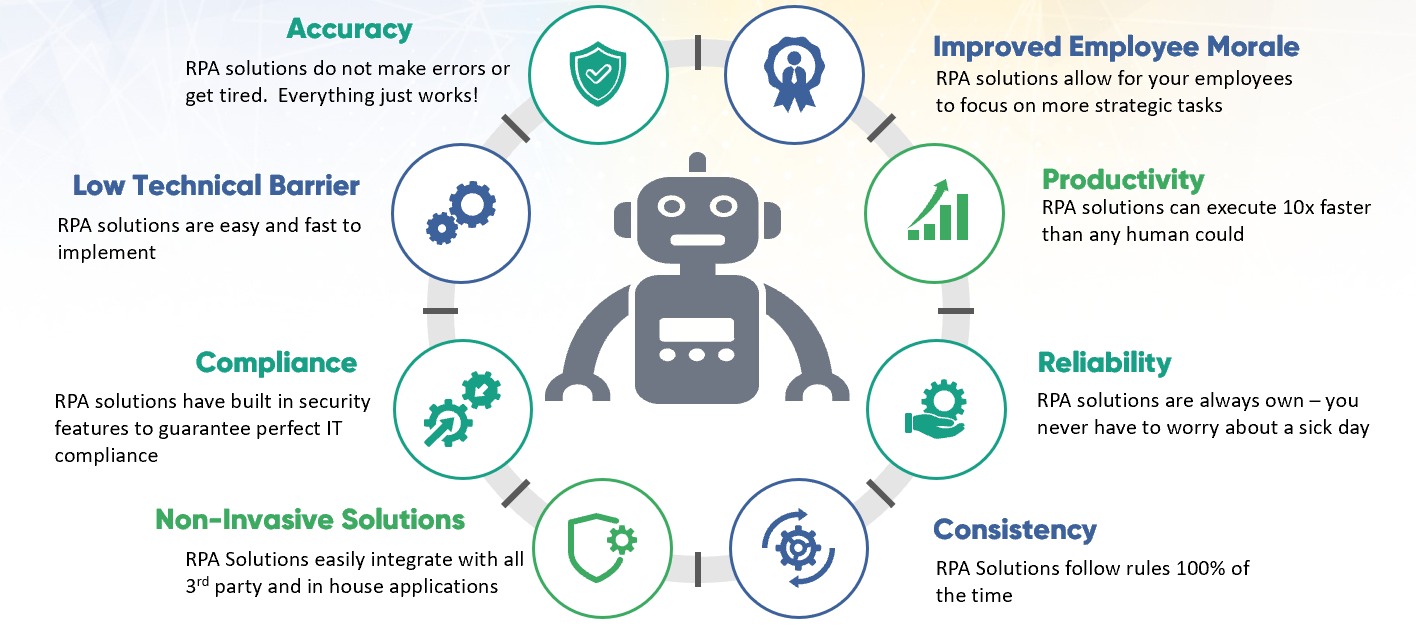
Robotic process automation (RPA) is the application of technology that allows employees to configure computer software or a “robot” to capture and interpret existing applications for processing transactions, manipulating data, triggering responses, and communicating with other digital systems. In simple words, RPA helps to build and manage software robots that mimic human actions interacting with digital systems.
Most importantly, RPA converts repetitive and mundane tasks into automated processes with RPA ‘bots’. This feature improves efficiency and accuracy within organizations by automating business processes. Additionally, it can help reduce costs by eliminating or automating low-value tasks, freeing up employees to work on more strategic initiatives.
RPA automates some of the rule-based actions that a human performs. Rule-based actions are simple algorithmic tasks that follow a certain logic, sequence, and structure. RPA reduces employee workload by combining computer vision, automation, and ML technologies in business processes.
Software developers program bots with RPA tools to perform repetitive tasks. Programming automates tasks that would have required human intervention. RPA systems, RPA software, RPA tools, and RPA technologies, essentially have the same meaning and are used interchangeably across the text.
Here are a few reasons why your business needs RPA:
According to Automation Anywhere, employees spend 10-25 percent of work hours on repetitive tasks. RPA can automate repetitive tasks to ensure higher productivity. RPA improves the performance of various business operations. According to a recent survey by NICE, 27 percent of managers reported improved productivity due to RPA.
RPA can perform a higher number of tasks than your small team of employees. If RPA takes over routine tasks, employees can focus on innovation and creative tasks. Better utilization of human resources helps to optimize the business processes effectively. In this way, Robotic Process Automation enables better productivity across workflows.
RPA technologies ensure higher efficiency in business processes. An RPA software can perform a routine task faster than a person. Robotic Process Automation technologies speed up simple tasks like email blasts, salary distribution, invoice processing, analytics, etc.
Additionally, RPA systems can simplify laborious tasks by up to 80 percent. RPA software can operate 24/7, and require no breaks. And thus, RPA improves efficiency across business processes.
RPA can perform a higher number of tasks than your small team of employees. If RPA takes over routine tasks, employees can focus on innovation and creative tasks. Better utilization of human resources helps to optimize the business processes effectively. In this way, Robotic Process Automation enables better productivity across workflows.
Humans tend to make mistakes; however, RPA tools don’t. RPA tools ensure better accuracy compared to manual work. RPA software eliminates the possibility of human errors through automation. RPA platforms are 100 percent error-free since they strictly follow the code embedded in their system.
For example, let us consider the data sorting process for a business. If businesses streamline input-output processes, RPA solutions can perform the tasks accurately. Maintaining a uniform format will make it easy for RPA software to analyze and sort data effectively. To process structured input data, RPA needs to be configured accordingly. These steps will enhance the overall accuracy of the process.
RPA is consistent and reliable, making it a necessary tool for any business. According to the Deloitte Global RPA Survey, 85 percent of staff confirmed that RPA meets and exceeds accuracy expectations. And so, to implement RPA, the business should plan, map, and optimize processes correctly.
Humans may leak data, intentionally or unintentionally. This error can bring serious consequences for businesses holding confidential data. Naturally, reducing the number of employees that have access to sensitive information will enhance data security.
RPA technologies remove human dependency and reduce data touchpoints. Unlike humans, automated processes cannot cause accidental security breaches. Thus, RPA ensures better security of data systems through automation.
Let us consider the example of workloads that vary. When workloads increase or decrease, managers need to scale their human resources. Onboarding employees requires tedious assessment and training. When the demand subsides, businesses struggle with the under-utilization of the HR bandwidth.
RPA tools easily cope with the variable workloads. Robotic automation is scalable and adjusts to the variation in demand/supply. And thus, Robotic Process Automation enhances scalability and reduces the financial impact of variations.
Data analysts need to analyze the changes in demand or supply, customer satisfaction levels, product success rates, etc. Analyzed data needs further processing, to provide valuable insights for effective management. It is time-consuming and cumbersome to repeatedly gather, monitor, and apply data about the organizational processes.
When the same parameters need to be measured, data analysis can seem repetitive. RPA technologies can be programmed to gather actionable data, perform data analysis, and present it to managers. Using RPA for data analytics reduces turnaround times, and enables managers to make better decisions in a short time.
Efficient data collection ensures better decision-making. RPA software simplifies the data analytics involved in business processes. Enhanced clarity and better data processing allow managers to have better control over the business. Thus, RPA can significantly speed up data collection and data processing for your business



Send us an email at contact@nustartech.com. Tell us how we can help you. We’ll get back to you sooner than you’d expect